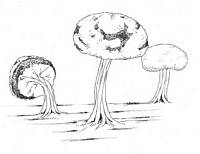|
 Didymium squamulosum Didymium squamulosum
SynonymsDidymium australe
Didymium effusum
Diderma squamulosum
BiostatusPresent in region - Indigenous. Non endemic
Images (click to enlarge)
Caption: Three sporangia of Didymium squamulosum, each of which is about1 mm tall.
Owner: S.L. Stephenson |
Article: Stephenson, S.L. (2003). Myxomycetes of New Zealand. Fungi of New Zealand. Ngā Harore o Aotearoa 3: xiv + 238 p. Hong Kong: Fungal Diversity Press.
Description: Fruiting body a stalked sporangium (but sometimes varying to sessile and plasmodiocarpous), scattered to gregarious, up to 1.5 mm tall. Sporotheca appearing globose or depressed, but usually discoid and deeply umbilicate below, 0.3–1.0 mm in diameter. Stalk stout, calcareous, usually more or less fluted but sometimes nearly smooth, white or ochraceous to orange or pinkish, arising from often attaining two-thirds the total height but sometimes very short and buried in the umbilicus or even lacking. Hypothallus discoid, membranous, nearly colourless to while. Peridium membranous, transparent, somewhat iridescent, usually covered with a thick, white crust of stellate lime crystals that often form a reticulate surface, the lime sometimes scanty, white, grey or rarely pinkish when fresh. Columella white or pale, discoid or hemispherical, consisting of the thickened, umbilicate sporangial base, with an expanded, subglobose or flattened tip. Capillitium variable, the threads slender or coarse, nearly simple or branching profusely, colourless or pallid, less commonly dark, often bearing conspicuous thickenings. Spores black in mass, dark violaceous brown by transmitted light, minutely warted or spiny, the warts sometimes clustered, 8–11 µm in diameter. Plasmodium colourless, white or yellow.
Habitat: Leaf litter, other types of plant debris, and the dung of herbivorous animals
Distribution: Considered as cosmopolitan by Martin & Alexopoulos (1969). The report by Berkeley (1855) of Didymium australe from New Zealand, based on a specimen collected by W. Colenso in Northland, probably can be referred to this species. Also known from Auckland (Kirk 1872), Coromandel, Wellington, Gisborne, Nelson, Dunedin (Lister & Lister 1905), Southland, Stewart Island (Lister & Lister 1905), the Chatham Islands, and Campbell Island.
Notes: Didymium squamulosum is often exceedingly common on the decaying fronds of nikau palm (Stephenson 2003). It is rather variable, particularly with respect to the length of the stalk.
|